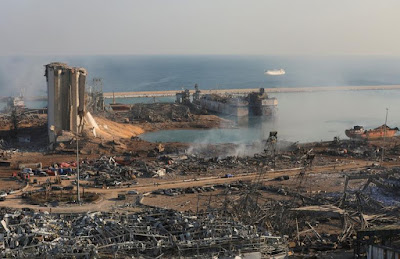Hundreds of Thousands Displaced By Beirut Explosion
On the afternoon of 4 August 2020, a team of 10 firefighters were dispatched to extinguish a warehouse fire at the Port of Beirut. A first, smaller, explosion sent a cloud of smoke above the fires and created flashes of light that were caused by a stash of fireworks stored in the warehouse. The second explosion was much more substantial and occurred at about 18:08 local time UTC+03:00. It rocked central Beirut and sent a red-orange cloud into the air, briefly surrounded by a white condensation cloud. The second blast was felt in northern Israel and in Cyprus, 240 kilometres (150 miles) away. The United States Geological Survey measured the blast as a 3.3 local magnitude earthquake, while the Jordan Seismological Observatory reported that it was equivalent to a 4.5 local magnitude earthquake. Specialists from the University of Sheffield in the United Kingdom estimated the blast had one-tenth the force of the atomic bomb dropped on Hiroshima, making it one of the biggest non-nuclear explosions in history. The Beirut explosion was similar to explosions of large amounts of ammonium nitrate in Tianjin, China, in 2015, in the city of West, Texas, in 2013, and in Texas City, Texas, in 1947.
The cause of the explosions was not immediately determined, although state media initially reported them taking place at a fireworks warehouse, while others placed them at an oil storage or chemical storage facility. There were warehouses in the port that stored explosives and chemicals including nitrates, common components of fertilizers and explosives. The Director General of Public Security stated the explosion was caused by the ammonium nitrate that was confiscated from the Rhosus. LBCI stated that, according to attendees of a Higher Defence Council briefing, the fire was ignited by workers welding a door at a[f] warehouse. Following the explosions, at least 135 people were confirmed dead, 80 missing and more than 5,000 injured. Nazar Najarian, the secretary-general of the Kataeb Party, died after suffering severe head injuries during the blast, and Kamal Hayek, chairman of the state-owned electricity company, was in critical condition. The Kazakhstani consul was wounded in his office.
The explosion overturned cars and stripped steel-framed buildings of their cladding.[69] Within the port area, the explosion destroyed a section of shoreline and left a crater nearly 120 metres (390 ft) in diameter. Witnesses said that homes as far as 10 kilometres (6 miles) away were damaged by the blast, and up to 300,000 people were left homeless by the explosions. The grain elevator, the city's second-largest, was destroyed, exacerbating food shortages caused by the COVID-19 pandemic and a severe financial crisis. About 15,000 tonnes of grain were destroyed, representing 85% of the city's grain reserves , and leaving the country with less than a month's worth of grain in reserve. The damage extended over half of Beirut, with the likely cost above $10 billion; 90% of hotels in the city were damaged and three hospitals completely destroyed, while two more suffered damage. Dozens of injured people brought to nearby hospitals could not be admitted because of the damage to the hospitals. Windows in buildings across the city were shattered, and residential homes over ten kilometres away were rendered unsuitable to live in Saint George Hospital is one of the city’s largest medical facilites.

















No comments